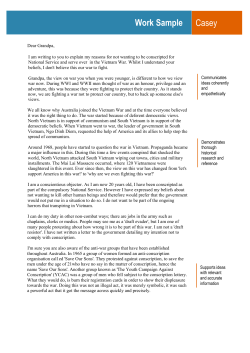
A v a i l a b l e o... j o u r n a l h o m...
VALUE IN HEALTH REGIONAL ISSUES 3C (2014) 24–26 Available online at www.sciencedirect.com journal homepage: www.elsevier.com/locate/vhri COMMENTARY “Socialization of Health Care” in Vietnam: What Is It and What Are Its Pros and Cons? Nguyen X. Thanh, MD, PhD, MPH1,2,, Bach X. Tran, PhD1,2,3, Arianna Waye, PhD1, Christa Harstall, MHSA1, Lars Lindholm, PhD4 1 Institute of Health Economics, Edmonton, Alberta, Canada; 2University of Alberta, School of Public Health, Edmonton, Alberta, Canada; 3Department of Health Economics, Hanoi Medical University, Hanoi, Vietnam; 4Umea International School of Public Health, Umea University, Umea, Sweden What Is “Socialization of Health Care” in Vietnam? Before 1989, the Vietnamese health care system was totally public funded. Citizens could access health care services free of charge. Because of a constrained health care budget, however, health care services could not meet the overall health needs of people in terms of quality and quantity. To overcome this, several policies for “socialization of health care” have been implemented. Vietnam’s socialization of health care means mobilizing all available and possible resources in society toward health care. The key component of this reform is the social mobilization of financial resources for health care through the following policies: implementation of user fees in public health care facilities (1989), legalization of private health care providers (1989), health insurance (1992), and financial autonomy in public hospitals (2002) (a kind of empowerment or power decentralization to public hospitals to generate and manage revenues by themselves). Subsequently, individuals directly finance a larger proportion of health care costs by out-of-pocket payments when they use health services (mostly based on the fee-for-service basis) or by paying for health insurance premiums monthly or yearly. Also, private actors finance a larger part of investments in health care when they open a private clinic or a private hospital, partner with a public hospital to open a “service-on-demand” ward (with pricier and higher quality health care services for patients who are willing and capable to pay), and/or purchase hi-tech diagnostic equipment (e.g., computed tomography scanner, magnetic resonance imaging, and color ultrasound machine) to share the profits with the hospital. Details about these policies have been published elsewhere [1]. In this article, we discuss about pros and cons associated with two main policies: the development of private clinics/hospitals, and the financial autonomy in public hospitals, including partial privatization of public hospitals (i.e., private investors partnering with public hospitals to purchase hi-tech diagnostic equipment). Pros Among several pros of the reform, we would like to mention three that we think are the most important. First, the reform has significantly increased available resources for health care and released the pressure to increase government budget reallocation to health care. Keep in mind that before the reform, 100% of public hospital revenues were from government funding. Since the reform, public hospitals have generated revenues from at least three sources, including government funding, health insurance, and patients’ out-of-pocket payments for hospital user fees. Although the government’s budget for health care is increasing yearly in absolute number, it accounted for only 42% of the public hospitals’ revenues in 2005. The remainder of hospital revenues was derived from other sources, including health insurance (16%), user fees (36%), and other (6%) [1]. In big cities where more revenues are mobilized for health care than in other places, the proportion of the government’s budget for health care is lower and the revenues from user fees are higher than the national average. For example, the government’s budget for public hospitals in Ho Chi Minh city increased from Vietnamese dong (VND) 518 billion (US $33 million) in 2004 to VND 720 billion (US $45 million) in 2006 but accounted for only 25% to 30% of the total revenues. Over the same time period, the revenues from user fees, including reimbursement from health insurance agencies, increased from VND 1114 million (US $71 million) to VND 1350 billion (US $84 million) and accounted for 60% to 65% of the total revenues [2] (US $1 ¼ 15,699 VND in 2004 and US $1 ¼ 15,996 VND in 2006) [3]. In terms of total health expenditure in Vietnam (about 6% of gross domestic product), public expenditure, Conflicts of interest: The authors have indicated that they have no conflicts of interest with regard to the content of this article. * Address correspondence to: Nguyen X. Thanh, Institute of Health Economics, #1200, 10405 Jasper Avenue, Edmonton, Alberta, Canada T5J 3N4. E-mail: tnguyen@ihe.ca. 2212-1099/$36.00 – see front matter Copyright & 2013, International Society for Pharmacoeconomics and Outcomes Research (ISPOR). Published by Elsevier Inc. http://dx.doi.org/10.1016/j.vhri.2013.09.006 VALUE IN HEALTH REGIONAL ISSUES 3C (2014) 24–26 including health insurance sources, accounts for only 30% compared with the private expenditure (70%) [1]. Second, private health care providers to some extent have reduced the heavy workloads in public health care facilities, especially in public hospitals. From none before the reform, up to 2008, Vietnam had 74 private hospitals with 5600 beds. Up to 2010, the number of private hospitals increased to 102 [4]. In addition, many private hospitals are licensed and being constructed. The country has more than 30,000 private clinics and 21,600 private pharmacies [1]. Of note, in addition to these licensed private facilities, there are many unlicensed practitioners, including public health staffs who practice privately at home after the government hours. It is reported that private health care providers provide 60% of all outpatient contacts in Vietnam [5] and provide care for 60% of all illness episodes [6]. The number of private hospital beds, however, is still limited, accounting for less than 5% of the total number of hospital beds in the country [7]. Finally, with the health care reform policies, the quality of health services has improved (at least in the structure domain [8]), with more investments in modern technologies, especially in diagnostics. Furthermore, competition among hospitals/ clinics to attract patients helps to improve the quality of health services. Income of health care staff has also increased substantially (about 1.5–2.5 times the base salary in some public hospitals) [1]. This may help improve the quality of health care services provided as more qualified staff is attracted and the risk for corruption is reduced. Patients can access health care services with higher quality easier because the improvement is not only in the big cities (e.g., Hanoi and Ho Chi Minh) but also in poorer and more remote provinces. For example, up to 2008, public hospitals in Quang Ninh province have raised VND 50 billion (US $3 million, US $1 ¼ 16,448 VND in 2008 [3]) (out of VND 3 trillion or US $182 million nationally) for investment in high technologies [1]. Cons The major cons of the reform that can be easily identified include the potential for “induced demand” by health care providers. Although quantitative evidence is currently unavailable to the knowledge of the authors, the induced demand problem is qualitatively reported frequently by the official mass media in Vietnam, such as the national television and newspapers [9]. Demand can be induced in at least four ways. First, patients are recommended to undergo too many diagnostic tests. In reality, this is because of the imbalance in medical knowledge, making it hard for patients to say “no” to the advice of doctors. This is coupled with the test repetition for those who are referred to another health care facility because one does not want to accept (or trust) the tests’ results done by another. Second, too many drugs are prescribed [10]. Sometimes they are unnecessary, harmless but costly. Sometimes they are even harmful such as antibiotics. For example, in a hospital in 2010, 90.4% of inpatients were prescribed the intravenous protein therapy and many were prescribed supplements, such as glutathione and arginine [11]. In another hospital in 2009, many normal delivery women were prescribed Klamentin (an antibiotic drug) for 16 consecutive days [12]. Third, hospitals tend to hospitalize patients with a condition that does not require inpatient care [9]. It is observed that many inpatients just come to hospitals to see doctors in the morning, stay there for a while (some hours) to receive treatments (if any), and go home in the afternoon or evening and then come back next morning, and so on. It is likely that these inpatients have a 25 minor condition and they should be treated as outpatients instead. Finally, hospitals tend to keep inpatients longer than necessary. This phenomenon is clearer for those patients who are covered by health insurance. According to Sepehri et al. [13], the hospital length of stay of insured patients increases by factors of 1.18 to 1.39. Consequently, there is an increase in health care expenditures for both patients (out-of-pocket) and health insurance agencies that may lead patients into a medical poverty trap (especially the poor and near-poor who are not covered by health insurance) and the insurance agencies into a situation that needs bailout from government or an increase in premiums. According to the Ministry of Health [14], the poor spends the equivalent of 17 months of household nonfood expenditures for each inpatient episode. The health gap between the poor and the rich increases, and care is allocated more according to ability to pay than need of care. Even the insurance companies face problems because health care bills for insured patients exceed health insurance premiums. According to Vietnam Social Insurance [15], this difference was VND 1709 billion (about US $100 million [3]) in 2009, 18% higher than that of the previous year. As a result, the premium of compulsory insurance for former-sector workers has increased from 3% to 4.5% of salary since 2009 [16]. In summary, Vietnam’s socialization of health care means to mobilize financial resources in society toward health care. In other words, it is a process of privatization. Besides the benefits of getting more financial investment, reducing the workload for public health care facilities, and increasing the quality of care, the reform faces problems of induced demand created by health care providers to maximize their benefits. There is, however, only qualitative evidence of this abusive behavior. A comprehensive study using both qualitative and quantitative methods is needed to confirm and measure the problem, as well as to identify the holes in current policies and regulations. Such information will definitely help policymakers find solutions. Source of financial support: This article was financially supported by the Institute of Health Economics, Edmonton, Alberta, Canada. R EF E R EN C ES [1] Ministry of Health of Vietnam and Health Partnership Group (MOH and HPG). Joint annual health review 2008: health financing in Vietnam. Available from: http://jahr.org.vn/index.php?option=com_content& view=frontpage&lang=en. [Accessed July 12, 2013]. [2] HCM City Health Department. Implementation of the “socialization of health care” in Ho Chi Minh city [in Vietnamese]. 2006. Available from: http://www.medinet.hochiminhcity.gov.vn/data/news/2006/8/3887/ thxhh.htm. [Accessed 26, 2012]. [3] US dollar (USD) to Vietnamese dong (VND) history. Available from: http://usd.fx-exchange.com/vnd/exchange-rates-history.html. [Accessed July 12, 2013]. [4] Ministry of Health of Vietnam and Health Partnership Group (MOH and HPG). Joint annual health review 2012: improving quality of medical services. Available from: http://jahr.org.vn/index.php?option=com_ content&view=frontpage&lang=en. [Accessed July 12, 2015]. [5] Ha NTH, Berman P, Larsen U. Household utilization and expenditure on private and public health services in Vietnam. Health Pol Plan 2002;17:61–70. [6] Thuan NTB, Lofgren C, Lindholm L, Chuc NTK. Choice of health care provider following reform in Vietnam. BMC Health Serv Res 2008;8:162. [7] Hort K. Private hospitals in Vietnam: recent growth and role in the health sector. 2011. Available from: http://ni.unimelb.edu.au/__data/ assets/pdf_file/0004/526927/private-hospitals-in-vietnam.pdf. [Accessed September 26, 2012]. [8] Donabedian A. The quality of care: how can it be assessed. JAMA 1988;260:1743–8. 26 VALUE IN HEALTH REGIONAL ISSUES 3C (2014) 24–26 [9] Vietnam Insurance Information 2012. Tag archives: hospitals [in Vietnamese]. Available from: http://tinbaohiem.com/tag/benh-vien/. [Accessed July 26, 2013]. [10] Vietnam Social Insurance. Insured patients are induced by doctors abusive behaviour: “the third-party-payment syndrome” [in Vietnamese]. 2011. Available from: http://www.baohiemxahoi.gov.vn/? u=nws&su=d&cid=384&id=4693. [Accessed July 26, 2013]. [11] Vietnam Social Insurance [in Vietnamese]. 2012. Available from: http:// www.anninhthudo.vn/Xa-hoi/Tram-nghin-kieu-truc-loi-Quy-Bao-hiemy-te/440594.antd. [Accessed July 26, 2013]. [12] Vietnam insurance information. A thousand and one ways to get money from the health insurance fund [in Vietnamese]. 2012. Available from: http://tinbaohiem.com/2012/1-001-chieu-rut-ruot-quy-bao-hiem-y-te-bai2-ep-nguoi-benh-dung-them-thuoc-thu-thuat/. [Accessed July 26, 2013]. [13] Sepehri A, Simpson W, Sarma S. The influence of health insurance on hospital admission and length of stay–the case of Vietnam. Soc Sci Med 2006;63:1757–70. [14] Ministry of Health. Vietnam health care report 2006: equity, efficiency, and development in new situation. 2007. Available from: http://jahr. org.vn/downloads/Nghien%20cuu/Khac/Vietnam%20National% 20Health%20Report%202006.pdf. [Accessed July 12, 2013]. [15] Vietnam Social Insurance [in Vietnamese]. 2010. Available from: http:// www.anninhthudo.vn/Xa-hoi/Quy-BHYT-boi-chi-hon-1700-ty-dong/ 365794.antd. [Accessed September 26, 2012]. [16] Tien TV, Phuong HT, Mathauer I, Phuong NTK. A health financing review of Vietnam with a focus on social health insurance. 2011. Available from: http://www.who.int/health_financing/documents/ oasis_f_11-vietnam.pdf. [Accessed September 26, 2012].
© Copyright 2025

















